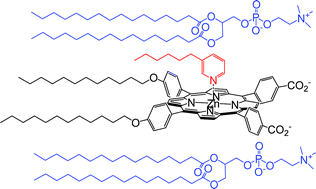Molecular recognition in anisotropic media. Binding of alkylpyridines to amphiphilic zinc porphyrins incorporated in liposomal bilayer membranes†
Abstract
Two amphiphilic zinc porphyrins were incorporated into liposomal bilayer membranes, egg phosphatidylcholine (Egg PC) and dipalmitoylphosphatidylcholine (DPPC). Binding free energy of alkylpyridines to the zinc porphyrins linearly increased as the length of the alkyl chains of the guest increased, showing that the guest was incorporated deep in the bilayer membranes in a hydrophobic environment. Comparison of the free energy increase per CH2 group indicated that recognition of 3-alkylpyridines were favored over that of 4-alkylpyridines by δΔΔG° = 0.3–0.7 kJ mol−1, and this preference was attributed to the anisotropy of the liposomal bilayer membranes. The binding was exothermic (ΔH° = −15 to −21 kJ mol−1) when the liposome was in a liquid crystalline phase, while it was endothermic (ΔH° = 53 to 62 kJ mol−1) when the liposome was in a gel phase. Local disorder of lipid molecules may be a driving force for binding in the latter case. Lipid bilayer membranes provide a unique medium for molecular recognition, in which the anisotropy and entropy of the lipid molecules add new features to binding.


 Please wait while we load your content...
Please wait while we load your content...